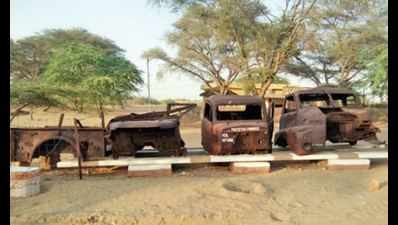- News
- City News
- jaipur News
- Longewala, 45 years after the battle
Trending
This story is from December 6, 2016
Longewala, 45 years after the battle
Pakistani forces began their attack at 12.30 am on December 5, 1971. But the enemy forces were devastated at the Indo-Pak Pillar 638. Forty-five years later, shattered pieces of Pakistani tanks and damaged vehicles can be seen Longewala.

Remains of Pakistani trucks which were destroyed in 1971 Indo-Pak war
Key Highlights
- Pakistani forces began their attack at 12.30 am on December 5, 1971. But the enemy forces were devastated at the Indo-Pak Pillar 638.
- Forty-five years later, shattered pieces of Pakistani tanks and damaged vehicles can be seen Longewala.
JAISALMER: A 2,000-strong Pakistan army had planned to have breakfast in Ramgarh, lunch at Jaisalmer and dinner at Jodhpur during the famous Longewala battle that began in the wee hours of December 5, 1971. But the script went awfully wrong as Pakistan’s army was devastated at the Indo-Pak Pillar 638.
Forty-five years later, shattered pieces of Pakistani tanks and damaged vehicles can be seen in the area in Longewala that speak volumes about the bravery of Indian jawans and BSF.
This battle scene is not only ‘alive’ today but thousands of anti-tank mines that were laid by the Indian army in the area of around 2x1 km on both sides of a road remain as witnesses to the battle. BSF and Army jawans do not venture into the area as it has been fenced from all sides. According to BSF officials, jawans have been directed to stay on a particular track in the area while patrolling.
To reach Longewala, one has to travel 105 km via Ramgarh from Jaisalmer. The Pakistani army tanks entered the Indian territory from border Pillar 638. It is common knowledge here that on the night of December 4, 1971, Lt Veer's platoon conducting a patrol detected noises from across the border, suggesting a large number of approaching armoured vehicles.
There is a well in an ancient village in Longewala which the Pakistani army poisoned while retreating after losing the battle in 1971.
Heer Singh of Gamnewala village, an eyewitness to the 1971 war, says the people of Longewala used to drink water from this well before 1971. But after the war, no one drinks water from this well even though the government had cleaned it. The village now has a new water source.
Forty-five years later, shattered pieces of Pakistani tanks and damaged vehicles can be seen in the area in Longewala that speak volumes about the bravery of Indian jawans and BSF.
This battle scene is not only ‘alive’ today but thousands of anti-tank mines that were laid by the Indian army in the area of around 2x1 km on both sides of a road remain as witnesses to the battle. BSF and Army jawans do not venture into the area as it has been fenced from all sides. According to BSF officials, jawans have been directed to stay on a particular track in the area while patrolling.
To reach Longewala, one has to travel 105 km via Ramgarh from Jaisalmer. The Pakistani army tanks entered the Indian territory from border Pillar 638. It is common knowledge here that on the night of December 4, 1971, Lt Veer's platoon conducting a patrol detected noises from across the border, suggesting a large number of approaching armoured vehicles.
The Pakistani forces began their attack at 12.30 am. As they approached the lone outpost, the artillery opened fire from across the border. But as the Indian Army went into offensive more from their earlier defensive position, the Pakistani army had no other option but to retreat.
There is a well in an ancient village in Longewala which the Pakistani army poisoned while retreating after losing the battle in 1971.
Heer Singh of Gamnewala village, an eyewitness to the 1971 war, says the people of Longewala used to drink water from this well before 1971. But after the war, no one drinks water from this well even though the government had cleaned it. The village now has a new water source.
End of Article
FOLLOW US ON SOCIAL MEDIA










